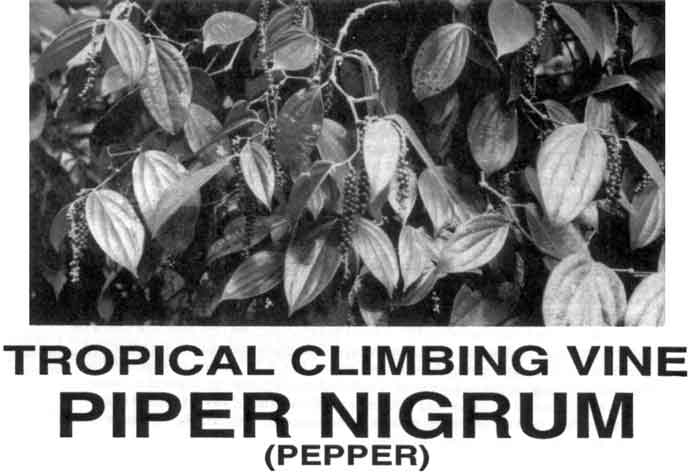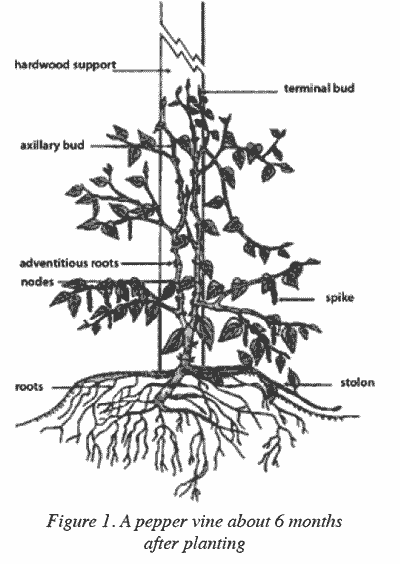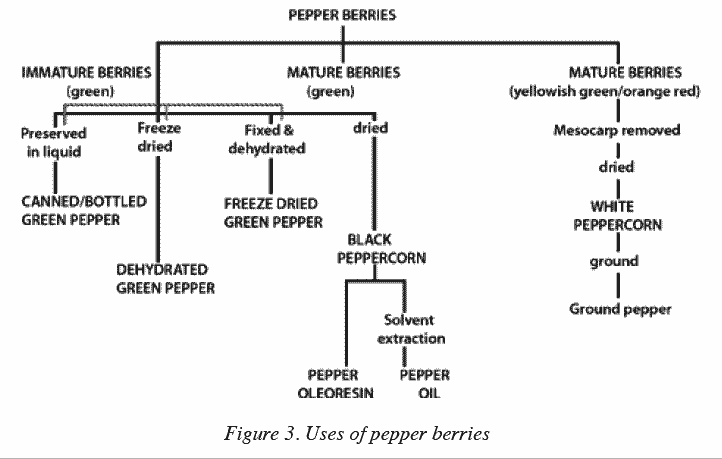
GROWING AND MARKETING PEPPERCORNS
SCIENTIFIC NAME: Piper nigrum
FAMILY: Piperaceae

Introduction
L & L Pepperfarms was established in 1984 after a down turn in the sugar industry forced the need to diversify into other horticultural crops. After working in Indonesia and the Philippines and seeing the diverse crops being cultivated, pepper stood out as a potential crop that could be grown in our tropical climate.
Pepper originated in the southwestern coastal region of India from where it spread to many parts of Asia, Africa and South America. Today, the southeast Asian countries of Malaysia, India, Indonesia, Thailand and Sri Lanka together with Brazil make up the IPC or International Pepper Community. World production has remained fairly constant at about 200,000 tonnes a year for export. Of this production the IPC countries produce 88%.
Table 1. World pepper production (figures from IPC)
| Table 1. World Pepper Production and export - countrywise (average, 1989- 1998) | ||
| Country | Production | Export |
| Brazil | 25,400 | 23,300 |
| India | 58,600 | 31,800 |
| Indonesia | 47,700 | 41,600 |
| Malaysia | 21,500 | 2,160 |
| Sri Lanka | 4,400 | 3,700 |
| Thailand | 8,600 | 2,300 |
| IPC Countries | 166,200 | 124,300 |
| Other Countries | 30,600 | 19,200 |
| World | 196,800 | 143,500 |
Non IPC countries growing pepper are Vietnam, China, Madagascar and Mexico, being minor contributors.
Whole black and white peppercorns account for 95% of pepper traded in the world. The remaining 5% is traded in the forms of pepper oleoresin, pepper oil, green pepper and ground pepper.
L & L Pepperfarms has currently 1.2 hectares under production with another 0.4 hectare coming online in 2 years.

The Pepper Plant
The pepper the world's most widely used spice is obtained from a tropical climbing vine, Piper nigrum and is from the Piperaceae family. It is a native plant of southwestern India.
They are normally grown from stem or terminal cuttings, rarely from seeds. The root system is developed from adventitious roots formed at the nodes, which are buried in the soil at planting. As the vegetative (orthotropic) shoot ascends, a simple leaf is produced at each node. A bunch of short adventitious roots is also formed to help the shoot adhere to the supports. At each node, there is an axillary bud, which develops into a lateral (plagiotropic) branch to bear the fruit spikes. Both the climbing and lateral shoots can branch upon cutting, but only the climbing shoots remain vegetative in growth. In the wild state the plant reaches lengths of 10 metres or more, but its growth under cultivation is controlled to ease harvesting.
The flower spike arises at the node opposite the leaf. Most cultivars have bisexual flowers, although male flowers are sometimes produced at the tips of the spikes. Flowers are mostly self-pollinated usually through wind although rain and ants may act as pollinating agents. The fruit is a berry, pale green and soft in the early stage, but turns dark green and hard as it develops. The outer skin (exocarp) becomes yellow and bright red and turns soft as it ripens. Each berry contains a single seed enclosed in a pulpy mesocarp. The commercial black peppercorn is the entire dried berry whereas the white peppercorn is the actual seed.
The peppercorn owes its pungency to the presence of alkaloids - piperine, chavicine and piperettine. The volatile essential oils impart the typical aroma of pepper. Together these compounds constitute the oleoresin, which can be recovered by solvent extraction. Varieties and also the growing locale influence the spiciness and pungency.
Soil and climatic requirements
The pepper is the fruit of perennial climbing vine that thrives in a warm and wet tropical climate. Moisture is required throughout the year as the plant is not able to withstand prolonged dryness. Low elevations give the best results and level ground is most suitable, provided there is no flooding. Soils should be well-drained, as waterlogging conditions result in poor growth and a high incidence of foot rot.
Cultivation
Terminal cuttings taken from 1 to 2-year-old plants usually propagate pepper. Traditionally, cuttings with five sections are used, with the bottom 3 buried in soil either in a nursery bed
or pots. About 12 weeks are required for rooting and development of buds. For field planting purposes we plant 3 cuttings directly beside the post with at least a 75% strike rate, eliminating the need for a nursery. Plants are planted at a density of 1900 per hectare.
Growing vines are trained up on support; hardwood posts are used, but we are looking for alternatives. We found that living posts of leguminous trees too difficult to maintain.
Vines must be pruned to encourage the formation of a desired canopy and encourage development of lateral branches. Initial pruning is done at 3 months and thereafter regularly until the vines reach the top of the support. After each harvest the terminal buds are trimmed to prevent further vertical growth. Occasional tying is needed to help train the vine up the post.
Pepper has high requirements for nutrients. Liming with dolomite is essential to improve Ca and Mg nutrition for the vines. Young vines must be fed frequently with N, P and K. N and K are in strong demand for mature vines. The vines should not be allowed to flower freely until they are 2 years old. Since it takes 8-9 months for the fruit to mature, the first harvest is around 3 years after planting.
Harvesting and processing
Spikes are usually thrown in December/January and are harvested around October/November. Pepper produces a minor and major crop in a year. Spikes are picked by hand when mature but still green. Unlike major producing countries where harvest is continuous over a 2-3 month period, for ease of management the crop is picked over a 2-week period. Once picked the berries are removed mechanically from the spike and then dried in the sun for 34 days. At present we are getting a 29% recovery rate from harvest to drying.
A small percentage of the crop is left to turn red and is then picked for processing into white pepper. The ripe berries are separated from the spike and then soaked in water to remove their pericarp and then sun dried.
Marketing
Pepper by virtue of its versatile use in the modem world has earned the reputation as the
King of spices. In developed countries, the usage of pepper in food industry has increased
substantially because of its taste, flavour and seasoning characteristics. More than 60% of
pepper is consumed in food industrial and food service sectors due to shift in the eating habits all over the world and the balance quantity is consumed in household, medicine, perfume, health and beauty segments. Ethnic foods particularly Indian, Chinese and Thai are having a growing impact in many countries and expanding to cover a wide range of tastes in food. In developing countries 90% of the pepper is consumed in the household segment.
Pepper both black and white is a principal spice being traded in the international spice market. Majority is traded in whole/unground state, though in recent years however, there has been a significant increase in the trade of value added pepper products from producing countries.
Pepper products, which are popularly traded internationally are pepper powder, green pepper, pepper oil and pepper oleoresin.

The demand/consumption of pepper is growing on average of 2.5% annually.
Pepper price tends to move in a cyclical way and price fluctuation can be very different from one year to the next. In general, price varies substantially, largely because of fluctuations in supply in major producing countries. The price swings were accentuated by speculative trading in the past, but this has been less evident in recent years.
There are different standards specification for pepper such as ESA (European Spice Association), ASTA (American Spice Trade Association) and ISO (Int. Standardisation Organisation) standards, in addition to different standards set by the major producing countries. The parameters, test methods, methods of drawing samples and definitions are different in many of the existing standards. We use the ASTA standard in regulating our quality.
Australia imports 2000 tonnes of various forms of pepper. Production from our 1.4 hectares varies according to pest and disease pressure and climatic conditions. We have established a niche market through a lot of hard footslogging and persistence. Higher world prices and our quality have seen our product hold its own with our buyers. At present we have concentrated on the dried market where we sell to wholesalers and also value add and sell direct to the supermarket chains in the north. A small percentage of our crop is sold as fresh green peppercorns into the markets. These are picked at the immature stage, as the berry needs to be soft inside to be edible. The next area for development is the pepper oil and oleoresin market.
The viability of pepper in the wet tropics will depend on world markets and prices and the ability to mechanise some of the processes involved in harvesting and processing. Traditionally pepper growing in undeveloped countries is on small holdings where fluctuations in prices determine the inputs the vines receive, low world prices-low inputs-lower production, hence the cyclical nature of this commodity.
DATE: August 2000
* * * * * * * * * * * * *
